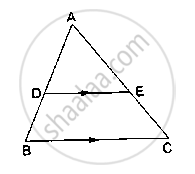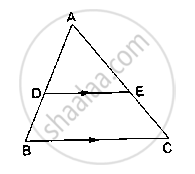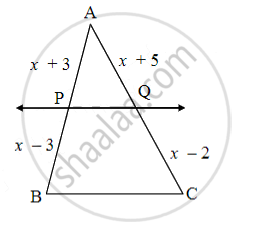Advertisements
Advertisements
Question
In the adjoining figure, ABC is a triangle in which AB = AC. IF D and E are points on AB and AC respectively such that AD = AE, show that the points B, C, E and D are concyclic.

Solution
Given:
AD = AE …(1)
AB = AC …(2)
Subtracting AD from both sides, we get:
⟹ AB – AD = AC – AD
⟹ AB – AD = AC - AE (Since, AD = AE)
⟹ BD = EC …(3)
Dividing equation (1) by equation (3), we get:
`(AD)/(DB)=(AE)/(EC)`
Applying the converse of Thales’ theorem, DE‖BC
⟹ ∠DEC + ∠ECB = 180° (Sum of interior angles on the same side of a
Transversal Line is 0°)
⟹ ∠DEC + ∠CBD = 180° (Since, AB = AC ⟹ ∠B = ∠C)
Hence, quadrilateral BCED is cyclic.
Therefore, B,C,E and D are concylic points.
APPEARS IN
RELATED QUESTIONS
In ΔABC, D and E are points on the sides AB and AC respectively such that DE || BC
If AD = 6 cm, DB = 9 cm and AE = 8 cm, find AC.
In ΔABC, D and E are points on the sides AB and AC respectively such that DE || BC
If AD = 4 cm, DB = 4.5 cm and AE = 8 cm, find AC.
In ΔABC, D and E are points on the sides AB and AC respectively such that DE || BC
If AD = 2.5 cm, BD = 3.0 cm and AE = 3.75 cm, find the length of AC.
D and E are points on the sides AB and AC respectively of a ΔABC such that DE║BC.
If AB = 13.3cm, AC = 11.9cm and EC = 5.1cm, find AD.

D and E are points on the sides AB and AC respectively of a ΔABC such that DE║BC.
If` (AD)/(AB) = 8/15 and EC = 3.5cm`, find AE.

A guy wire attached to a vertical pole of height 18 m is 24m long and has a stake attached to the other end. How far from the base of the pole should the stake be driven so that the wire will be taut?
Find the height of an equilateral triangle of side 12cm.
Find the length of each side of a rhombus whose diagonals are 24cm and 10cm long.
State and converse of Thale’s theorem.
From fig., seg PQ || side BC, AP = x + 3, PB = x – 3, AQ = x + 5, QC = x – 2, then complete the activity to find the value of x.
In ΔPQB, PQ || side BC
`"AP"/"PB" = "AQ"/(["______"])` ...[______]
`(x + 3)/(x - 3) = (x + 5)/(["______"])`
(x + 3) [______] = (x + 5)(x – 3)
x2 + x – [______] = x2 + 2x – 15
x = [______]
